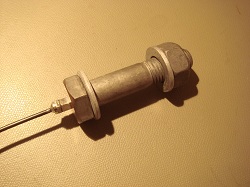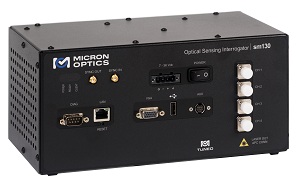May
25
2012
Not really, but what follows is a fun article by a key Micron Optics Integrator, INFAP, in Germany. Applications like these often rely on integrators’ ingenuity in packaging FBGs for a particular purpose. If you have a measurement challenge in mind but fear that proper sensors do not exist, installation might be tricky, or the environment might be too harsh, contact us. Our systems integrators, like INFAP, may have the answers you need.
- Tom Graver
Sculpture Mae West with INFAP measuring technology
Or: Measurement technology can be so sexy
by INFAP


Mae (Mary Jane) West (1893-1980),an American actress and screenwriter, was one of the top film stars of the 1930s. In early 2011, a monument for the actress was completed in Munich at the Effnerplatz. The sculpture was designed by the artist Rita McBride and consists of a 52 m high construction of 32 carbon fiber enhancing plastic pipes and weighs approximately 200 tonnes. At the lower level the Paraboloid consists of CFK jacketed steel tubes. The sculpture was completed on 30 January 2011


In cooperation with the Munich-based engineering firm Zilch & Mülle, Infap has developed a novel sensor, the IFSS 2085 to monitor the state of the building on a long term basis. The screw sensor is based on fiber optic sensor technology. Physical properties such as acceleration, strain, pressure or temperature changes can be measured and transmitted optically with light waves.
The measurement approach includes screw sensors, strain sensors, temperature sensors and acceleration sensors that supply fiber optic measurement data from the respective sectors. The signals are captured by a small optical interrogation unit, the Micron Optics sm130. Structural changes can then be detected very precisely.
About INFAP:
INFAP GmbH is offering industrial fiber optical applications. INFAP is active with its fibre optic measurement systems in various branches and industries. Based on the “know how” of the employees INFAP GmbH can draw experience in the optical field of over 25 years. INFAP GmbH offers standard fiber optic measurement systems as well as customized application-specific systems for their customers.
Mar
20
2012

For years, Micron Optics has touted the benefits of fiber optic sensors – specifically fiber Bragg grating (FBG) based strain and temperature sensors. We have worked to make clear that we do not see FBG sensors as an across-the-board replacement for conventional foil strain gages or thermocouples. They’re not. FBG sensors make sense where there is a special challenge that is addressed by one of many inherent advantages of fiber optic sensors.
National Instruments has done a good job of highlighting some examples of this in a recent “NI Developer Zone” blog post. It focuses on FBG’s immunity to EMI, intrinsically safe operation, multiplexing capability and small size and how these attributes address needs in important fields of application. See the complete post here:
http://zone.ni.com/devzone/cda/pub/p/id/1523metc=mt4psm
National Instruments recognizes how fiber optic sensors enhance their capability to address a much broader field of sensor applications. Kellis Garret, Product Marketing Engineer for NI’s fiber optic sensing instruments, says “Many of our customers are just learning about the power of FOS and are now making measurements that simply were not possible with conventional gages.” Look for more FOS information at ni.com, including NI-OSI (NI’s FOS interface), LabVIEW drivers for Micron Optics interrogators, and training tools to bring yourself and your team current on FOS technologies.
- Tom Graver
Feb
14
2012
In May of 2011, I blogged about a fiber-optic-based rock deformation measurement system at the Sanford Underground Research Facility (SURF) (formerly the Sanford Underground Science and Engineering Laboratory (SUSEL)). www.sanfordundergroundlaboratoryathomestake.org .
SURF is an interim facility under construction while DUSEL funding is pending from the DOE. Last week, Fermilab www.fnal.gov hosted a DuRa meeting attended by physicists and scientists from all over the world. This meeting was held to update the community on the progress of the current and future experiments at SURF.
During the meeting members of DuRa viewed a live feed of an experiment at the 4100ft level of the Homestake Mine in Lead, SD. This experiment involved loading the rock mass with a 100 ton capacity jack. More than 30 FBG based strain gages recorded the rock deformation during loading.
Both “strain strips” (a clever embedded strain measurement transducer created by the GEOXTM Team) and Micron Optics os3600 long gage strain sensors, embedded and mounted on the surface, successfully measured changes in the rock as small as a few microns.
This system has been live 24\7 for nearly three years. Stay tuned as I will post the new data as it becomes available.
To view the pre-recorded “live” feed follow this link : http://vmsstreamer1.fnal.gov/VMS_Site_02/Lectures/DURA/120119Roggenthen/index.htm
Note this link best viewed with Firefox or Safari as some viewers had issues with viewing in IE.
You can also view some quick data plots from the experiment.
Alan Turner
Jun
29
2011
Micron Optics announced the installation of one of their state of the art optical interrogation systems on one of the nation’s most famous monuments, Mount Rushmore. The Rock Block Monitoring System (RBMS) will provide the National Park Service with critical information about shifts in the rock system which makes up the Mount Rushmore National Monument. The RBMS was installed in partnership with Respec Inc. and the Mount Rushmore Rope Access Team and is composed of one Micron Optics sm125 Optical Sensing Interrogator and 36 sensors.
For more information, see the full press release or read the case study on the website.




